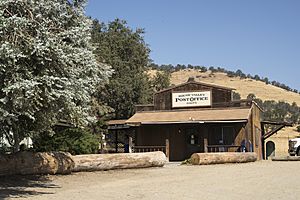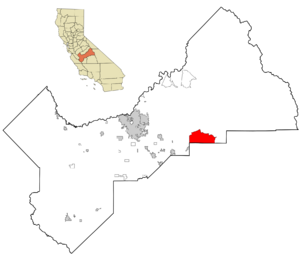Yokuts Valley, California facts for kids
Quick facts for kids
Yokuts Valley, California
|
|
|---|---|

The Post Office in Yokuts Valley in 2018, before the community's name change
|
|

Location in Fresno County and the state of California
|
|
| Country | |
| State | |
| County | Fresno |
| Named for | The Yokuts, an Indigenous ethnic group comprising many tribes of Central California |
| Area | |
| • Total | 63.669 sq mi (164.901 km2) |
| • Land | 63.614 sq mi (164.758 km2) |
| • Water | 0.055 sq mi (0.143 km2) 0.09% |
| Elevation | 1,631 ft (497 m) |
| Population
(2020)
|
|
| • Total | 3,564 |
| • Density | 55.977/sq mi (21.6130/km2) |
| Time zone | UTC-8 (PST) |
| • Summer (DST) | UTC-7 (PDT) |
| ZIP codes |
93646, 93675
|
| Area code(s) | 559 |
| GNIS feature IDs | 1659853, 2408799 |
Yokuts Valley, once known as Squaw Valley, is a small community in Fresno County, California. It is located at the base of the Sierra Nevada mountains. You can find it along California State Route 180, just below Kings Canyon National Park.
In 2020, about 3,564 people lived in Yokuts Valley. This was an increase from 3,162 people in 2010. The United States Census Bureau officially calls Yokuts Valley a "census-designated place" (CDP). This means it's a special area set up for counting people. Yokuts Valley is about 9 miles (14 km) northeast of Orange Cove. It is also about 30 miles (48 km) east of Fresno. The community sits at an elevation of about 1,631 feet (497 m) above sea level.
Contents
The Name of Yokuts Valley
Original Names and Meanings
The Yokuts tribe, called the Chukimena, lived in this valley long ago. They named their main village Múshtihnau. Another nearby Yokuts tribe, the Éntimbits, called the valley Túcheu. The word "Valley" first referred to the whole area or a narrow valley connecting to the San Joaquin Valley. Today, it means both.
Some believe the area was first called "Woman's Land." This was because of a rock with a shape like a woman's moccasin print.
How "Squaw Valley" Came to Be
By 1873, non-native hunters started using the name "Squaw Valley." They used the word "squaw" for Indigenous women. However, this word is now seen as a very offensive term by Native people. The United States Board on Geographic Names (BGN) officially named the community "Squaw Valley" in 1957. They named the surrounding basin "Squaw Valley" in 1959.
Confusion with Another Valley
On August 28, 1958, the BGN decided that "Squaw Valley" would only refer to this community. This was to avoid confusion with a new community in Placer County. That other community was getting ready to host the 1960 Winter Olympics. It later became known as Olympic Valley. Even so, people still informally called both places "Squaw Valley," which caused a lot of mix-ups.
Changing the Name to Yokuts Valley
From 2020 to 2023, a group including members of local tribes worked to change the community's name. They first suggested "Nuum Valley" and then "Yokuts Valley." They wanted the name changed because the old name was offensive.
In September 2022, the Board on Geographic Names renamed the surrounding valley to Yokuts Basin. This was part of a plan to remove the offensive word from place names across the country. A local leader, Nathan Magsig, asked 1,400 households for their thoughts. He said most preferred "Bear Valley." He held a meeting that became quite heated. Some people did not want the name changed because residents had not chosen the new name. Others refused to believe the word "squaw" was offensive. Native activists and some white residents supported the change. They wanted to remove a name that was disrespectful to Indigenous women.
A few days later, Governor Gavin Newsom signed a law. This law required state and local groups to remove the offensive word from all place names in California by 2025. In October, the Fresno County Board of Supervisors agreed with the state and federal efforts. However, they also told the federal government that 87% of the households who responded to the survey did not want the community's name changed.
In January 2023, the Board on Geographic Names finished reviewing the name change. They decided to rename the community "Yokuts Valley." In February, a welcome sign with the old name was taken down. Some local residents then asked for it to be put back up.
History of Yokuts Valley
Early Settlers and Post Office
The area we now call Yokuts Valley was originally home to the Yokuts and Mono people. In 1869, the Simpson Drake family became the first non-Indigenous family to settle there. An early mention of Yokuts Valley appeared in an Idaho newspaper in 1884.
The first post office opened in "Squaw Valley" in 1879. Its name changed to Squawvalley in 1895. It then closed in 1918. It reopened in 1923, changed back to Squaw Valley in 1932, and closed again in 1945. Mail then went through the Orange Cove post office. The "Squaw Valley" post office opened for a third time in 1960.
Community Growth
In the 1960s, the community moved east to where it is today. In 1994, the Fresno County Public Library's Bear Mountain Branch Library moved to Yokuts Valley. It had been in Dunlap since 1915.
Geography and Area
Yokuts Valley is located in the Yokuts Basin. The United States Census Bureau states that the community covers about 63.7 square miles (164.9 km2). Almost all of this area is land. The Squaw Valley-Miramonte AVA is a grape-growing region that is centered around the community.
Population Information
Population in 2020
The 2020 United States census showed that Yokuts Valley had a population of 3,564 people. The population density was about 56.0 people per square mile (21.6 people/km2).
- Most residents (72.3%) were White.
- A small number were African American (0.7%), Native American (2.3%), or Asian (2.9%).
- About 8.3% were from other races, and 13.6% were from two or more races.
- Hispanic or Latino people made up 21.0% of the population.
Almost everyone (99.7%) lived in homes. There were 1,398 households. About 22.8% of these households had children under 18. The average household had 2.54 people. The median age was 49.7 years. For every 100 females, there were about 113.9 males.
There were 1,636 housing units. Most (85.5%) were lived in. About 84.9% of homes were owned by the people living in them. The rest (15.1%) were rented.
In 2023, the average household income was estimated to be $81,094. The average income per person was $35,815. About 15.0% of the population lived below the poverty line.
Population in 2010
The 2010 United States Census reported that Yokuts Valley had 3,162 people. The population density was about 55.9 people per square mile (21.6 people/km2).
- Most residents (85.4%) were White.
- Hispanic or Latino people made up 16.6% of the population.
Almost everyone (99.9%) lived in homes. There were 1,188 households. About 28.9% had children under 18. The average household had 2.66 people. The median age was 46.3 years. For every 100 females, there were about 103.2 males.
There were 1,419 housing units. Most (84.9%) were owned, and 15.1% were rented.
Local Government
Yokuts Valley is an "unincorporated community." This means it does not have its own local government like a city. Instead, Fresno County services and special districts manage the area. Yokuts Valley is part of Supervisorial District 5. The Kings Canyon Unified School District serves the schools in this mountain area. The Fresno County Sheriff's Office has a local office in Yokuts Valley to help keep the community safe.
Notable People
- Stuart Erwin – an actor
- Don Knight – an actor
See also
 In Spanish: Yokuts Valley para niños
In Spanish: Yokuts Valley para niños


